Workplace Health And Safety Assesment Report
VerifiedAdded on 2022/08/21
|13
|2834
|15
AI Summary
Contribute Materials
Your contribution can guide someone’s learning journey. Share your
documents today.
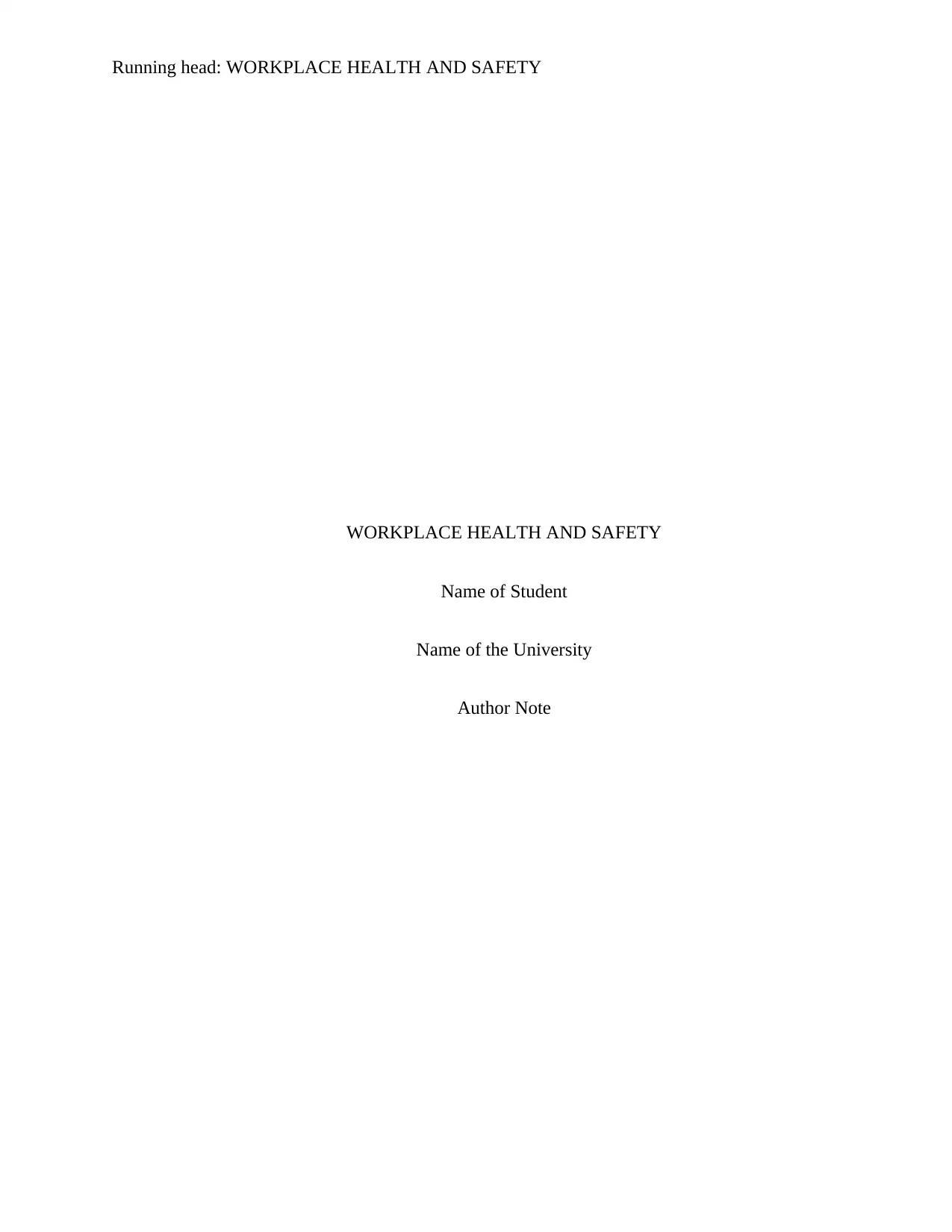
Running head: WORKPLACE HEALTH AND SAFETY
WORKPLACE HEALTH AND SAFETY
Name of Student
Name of the University
Author Note
WORKPLACE HEALTH AND SAFETY
Name of Student
Name of the University
Author Note
Secure Best Marks with AI Grader
Need help grading? Try our AI Grader for instant feedback on your assignments.
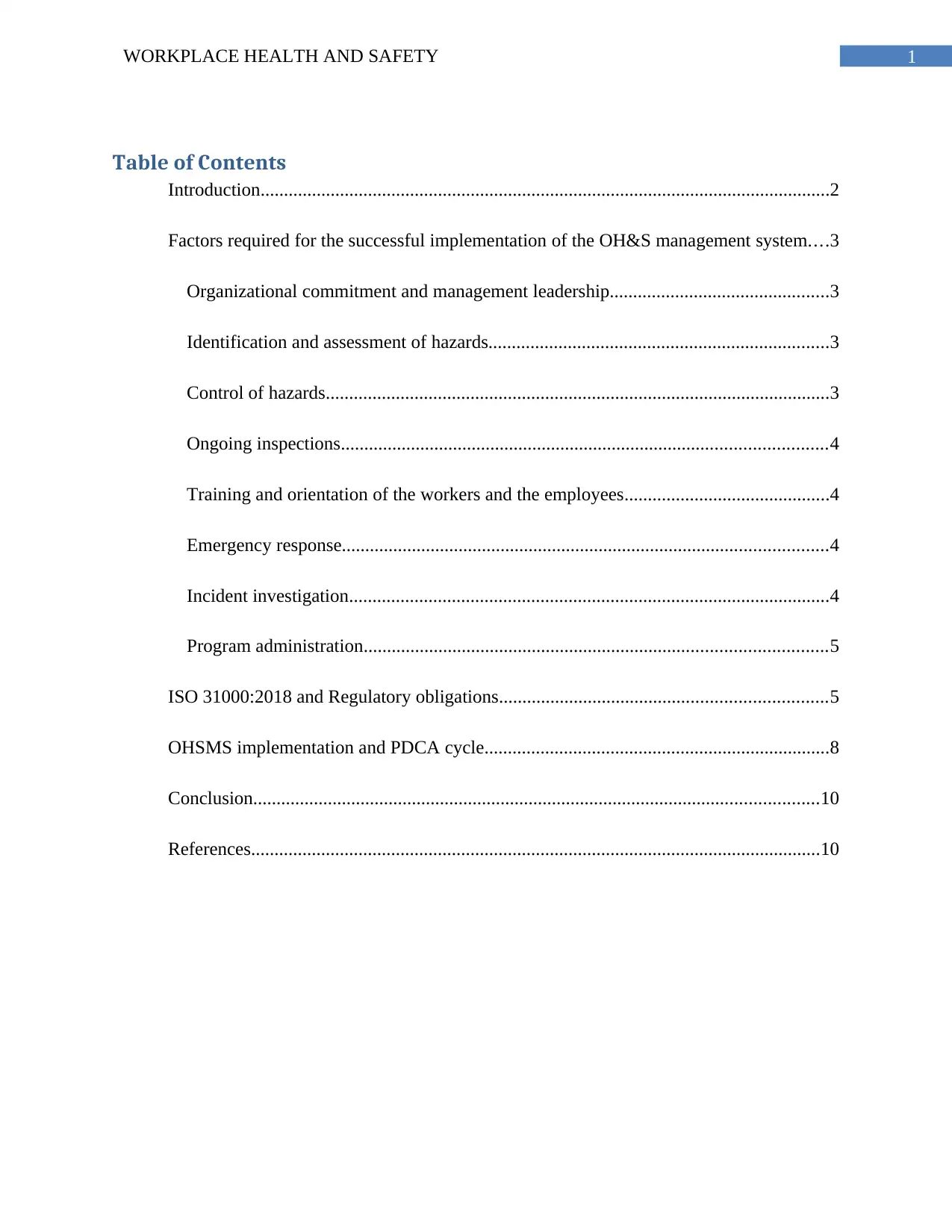
1WORKPLACE HEALTH AND SAFETY
Table of Contents
Introduction..........................................................................................................................2
Factors required for the successful implementation of the OH&S management system....3
Organizational commitment and management leadership...............................................3
Identification and assessment of hazards.........................................................................3
Control of hazards............................................................................................................3
Ongoing inspections........................................................................................................4
Training and orientation of the workers and the employees............................................4
Emergency response........................................................................................................4
Incident investigation.......................................................................................................4
Program administration...................................................................................................5
ISO 31000:2018 and Regulatory obligations......................................................................5
OHSMS implementation and PDCA cycle..........................................................................8
Conclusion.........................................................................................................................10
References..........................................................................................................................10
Table of Contents
Introduction..........................................................................................................................2
Factors required for the successful implementation of the OH&S management system....3
Organizational commitment and management leadership...............................................3
Identification and assessment of hazards.........................................................................3
Control of hazards............................................................................................................3
Ongoing inspections........................................................................................................4
Training and orientation of the workers and the employees............................................4
Emergency response........................................................................................................4
Incident investigation.......................................................................................................4
Program administration...................................................................................................5
ISO 31000:2018 and Regulatory obligations......................................................................5
OHSMS implementation and PDCA cycle..........................................................................8
Conclusion.........................................................................................................................10
References..........................................................................................................................10
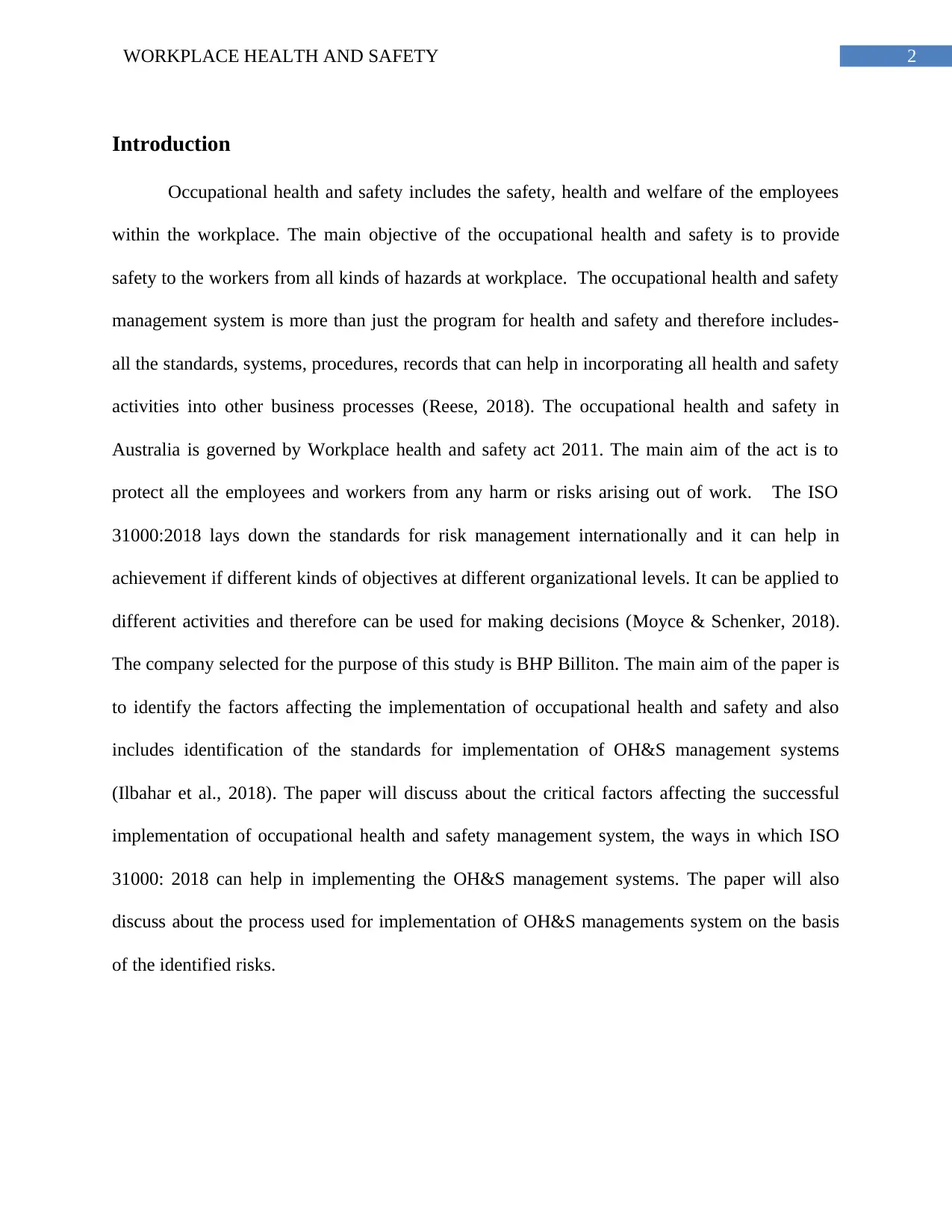
2WORKPLACE HEALTH AND SAFETY
Introduction
Occupational health and safety includes the safety, health and welfare of the employees
within the workplace. The main objective of the occupational health and safety is to provide
safety to the workers from all kinds of hazards at workplace. The occupational health and safety
management system is more than just the program for health and safety and therefore includes-
all the standards, systems, procedures, records that can help in incorporating all health and safety
activities into other business processes (Reese, 2018). The occupational health and safety in
Australia is governed by Workplace health and safety act 2011. The main aim of the act is to
protect all the employees and workers from any harm or risks arising out of work. The ISO
31000:2018 lays down the standards for risk management internationally and it can help in
achievement if different kinds of objectives at different organizational levels. It can be applied to
different activities and therefore can be used for making decisions (Moyce & Schenker, 2018).
The company selected for the purpose of this study is BHP Billiton. The main aim of the paper is
to identify the factors affecting the implementation of occupational health and safety and also
includes identification of the standards for implementation of OH&S management systems
(Ilbahar et al., 2018). The paper will discuss about the critical factors affecting the successful
implementation of occupational health and safety management system, the ways in which ISO
31000: 2018 can help in implementing the OH&S management systems. The paper will also
discuss about the process used for implementation of OH&S managements system on the basis
of the identified risks.
Introduction
Occupational health and safety includes the safety, health and welfare of the employees
within the workplace. The main objective of the occupational health and safety is to provide
safety to the workers from all kinds of hazards at workplace. The occupational health and safety
management system is more than just the program for health and safety and therefore includes-
all the standards, systems, procedures, records that can help in incorporating all health and safety
activities into other business processes (Reese, 2018). The occupational health and safety in
Australia is governed by Workplace health and safety act 2011. The main aim of the act is to
protect all the employees and workers from any harm or risks arising out of work. The ISO
31000:2018 lays down the standards for risk management internationally and it can help in
achievement if different kinds of objectives at different organizational levels. It can be applied to
different activities and therefore can be used for making decisions (Moyce & Schenker, 2018).
The company selected for the purpose of this study is BHP Billiton. The main aim of the paper is
to identify the factors affecting the implementation of occupational health and safety and also
includes identification of the standards for implementation of OH&S management systems
(Ilbahar et al., 2018). The paper will discuss about the critical factors affecting the successful
implementation of occupational health and safety management system, the ways in which ISO
31000: 2018 can help in implementing the OH&S management systems. The paper will also
discuss about the process used for implementation of OH&S managements system on the basis
of the identified risks.

3WORKPLACE HEALTH AND SAFETY
Factors required for the successful implementation of the OH&S management
system
Some of the main critical factors that are necessary for the successful implementation of
the occupational health and safety management system includes- Organizational commitment
and management leadership, identification and assessment of hazard, control of hazard, ongoing
inspections, proper training and orientation of the employees and ensuring they have the required
skills and knowledge set for dealing with such situations, emergency response, incident
investigation and program administration (Mohammadfam et al., 2017).
Organizational commitment and management leadership
The management needs to show an initiative from their part so that the occupational
health and safety management system can work smoothly (Gul & Ak, 2018). Therefore they
need to be committed to making a safe workplace. The management needs to prepare a proper
policy for ensuring workplace health and safety that should be including the duties and the
responsibilities of the workers and the employers.It should also include the objectives and gaols
of health and safety systems.
Identification and assessment of hazards
In order to ensure the successful implementation of the OH&S management system, it is
necessary to first identify the risk at workplace and then everything needs to be assessed that
could have been done or that actually happened.
Control of hazards
Once the problem has been identified, actions can be taken to overcome the sane and for
the purpose of preventing it from happening again. There are usually three main methods of
Factors required for the successful implementation of the OH&S management
system
Some of the main critical factors that are necessary for the successful implementation of
the occupational health and safety management system includes- Organizational commitment
and management leadership, identification and assessment of hazard, control of hazard, ongoing
inspections, proper training and orientation of the employees and ensuring they have the required
skills and knowledge set for dealing with such situations, emergency response, incident
investigation and program administration (Mohammadfam et al., 2017).
Organizational commitment and management leadership
The management needs to show an initiative from their part so that the occupational
health and safety management system can work smoothly (Gul & Ak, 2018). Therefore they
need to be committed to making a safe workplace. The management needs to prepare a proper
policy for ensuring workplace health and safety that should be including the duties and the
responsibilities of the workers and the employers.It should also include the objectives and gaols
of health and safety systems.
Identification and assessment of hazards
In order to ensure the successful implementation of the OH&S management system, it is
necessary to first identify the risk at workplace and then everything needs to be assessed that
could have been done or that actually happened.
Control of hazards
Once the problem has been identified, actions can be taken to overcome the sane and for
the purpose of preventing it from happening again. There are usually three main methods of
Secure Best Marks with AI Grader
Need help grading? Try our AI Grader for instant feedback on your assignments.
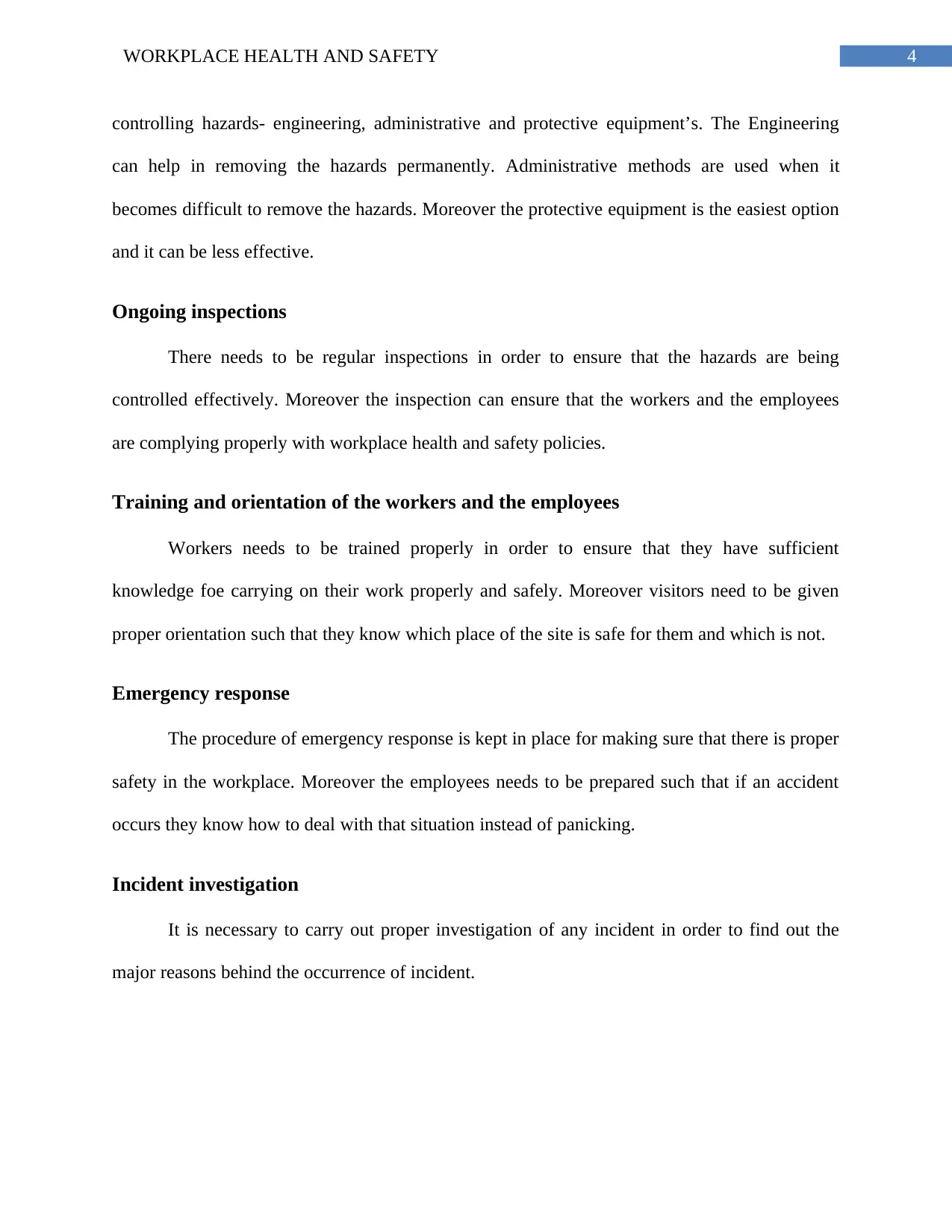
4WORKPLACE HEALTH AND SAFETY
controlling hazards- engineering, administrative and protective equipment’s. The Engineering
can help in removing the hazards permanently. Administrative methods are used when it
becomes difficult to remove the hazards. Moreover the protective equipment is the easiest option
and it can be less effective.
Ongoing inspections
There needs to be regular inspections in order to ensure that the hazards are being
controlled effectively. Moreover the inspection can ensure that the workers and the employees
are complying properly with workplace health and safety policies.
Training and orientation of the workers and the employees
Workers needs to be trained properly in order to ensure that they have sufficient
knowledge foe carrying on their work properly and safely. Moreover visitors need to be given
proper orientation such that they know which place of the site is safe for them and which is not.
Emergency response
The procedure of emergency response is kept in place for making sure that there is proper
safety in the workplace. Moreover the employees needs to be prepared such that if an accident
occurs they know how to deal with that situation instead of panicking.
Incident investigation
It is necessary to carry out proper investigation of any incident in order to find out the
major reasons behind the occurrence of incident.
controlling hazards- engineering, administrative and protective equipment’s. The Engineering
can help in removing the hazards permanently. Administrative methods are used when it
becomes difficult to remove the hazards. Moreover the protective equipment is the easiest option
and it can be less effective.
Ongoing inspections
There needs to be regular inspections in order to ensure that the hazards are being
controlled effectively. Moreover the inspection can ensure that the workers and the employees
are complying properly with workplace health and safety policies.
Training and orientation of the workers and the employees
Workers needs to be trained properly in order to ensure that they have sufficient
knowledge foe carrying on their work properly and safely. Moreover visitors need to be given
proper orientation such that they know which place of the site is safe for them and which is not.
Emergency response
The procedure of emergency response is kept in place for making sure that there is proper
safety in the workplace. Moreover the employees needs to be prepared such that if an accident
occurs they know how to deal with that situation instead of panicking.
Incident investigation
It is necessary to carry out proper investigation of any incident in order to find out the
major reasons behind the occurrence of incident.
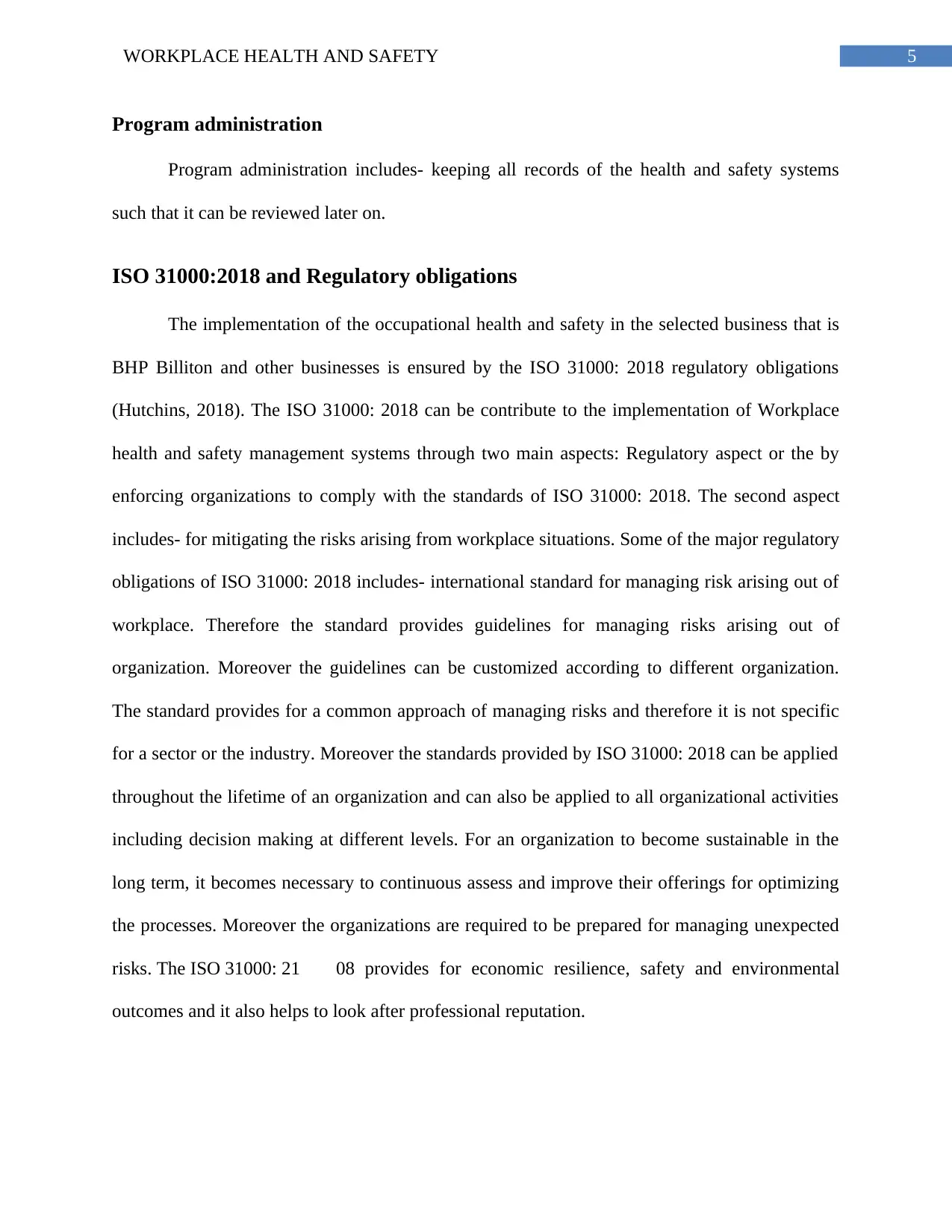
5WORKPLACE HEALTH AND SAFETY
Program administration
Program administration includes- keeping all records of the health and safety systems
such that it can be reviewed later on.
ISO 31000:2018 and Regulatory obligations
The implementation of the occupational health and safety in the selected business that is
BHP Billiton and other businesses is ensured by the ISO 31000: 2018 regulatory obligations
(Hutchins, 2018). The ISO 31000: 2018 can be contribute to the implementation of Workplace
health and safety management systems through two main aspects: Regulatory aspect or the by
enforcing organizations to comply with the standards of ISO 31000: 2018. The second aspect
includes- for mitigating the risks arising from workplace situations. Some of the major regulatory
obligations of ISO 31000: 2018 includes- international standard for managing risk arising out of
workplace. Therefore the standard provides guidelines for managing risks arising out of
organization. Moreover the guidelines can be customized according to different organization.
The standard provides for a common approach of managing risks and therefore it is not specific
for a sector or the industry. Moreover the standards provided by ISO 31000: 2018 can be applied
throughout the lifetime of an organization and can also be applied to all organizational activities
including decision making at different levels. For an organization to become sustainable in the
long term, it becomes necessary to continuous assess and improve their offerings for optimizing
the processes. Moreover the organizations are required to be prepared for managing unexpected
risks. The ISO 31000: 21 08 provides for economic resilience, safety and environmental
outcomes and it also helps to look after professional reputation.
Program administration
Program administration includes- keeping all records of the health and safety systems
such that it can be reviewed later on.
ISO 31000:2018 and Regulatory obligations
The implementation of the occupational health and safety in the selected business that is
BHP Billiton and other businesses is ensured by the ISO 31000: 2018 regulatory obligations
(Hutchins, 2018). The ISO 31000: 2018 can be contribute to the implementation of Workplace
health and safety management systems through two main aspects: Regulatory aspect or the by
enforcing organizations to comply with the standards of ISO 31000: 2018. The second aspect
includes- for mitigating the risks arising from workplace situations. Some of the major regulatory
obligations of ISO 31000: 2018 includes- international standard for managing risk arising out of
workplace. Therefore the standard provides guidelines for managing risks arising out of
organization. Moreover the guidelines can be customized according to different organization.
The standard provides for a common approach of managing risks and therefore it is not specific
for a sector or the industry. Moreover the standards provided by ISO 31000: 2018 can be applied
throughout the lifetime of an organization and can also be applied to all organizational activities
including decision making at different levels. For an organization to become sustainable in the
long term, it becomes necessary to continuous assess and improve their offerings for optimizing
the processes. Moreover the organizations are required to be prepared for managing unexpected
risks. The ISO 31000: 21 08 provides for economic resilience, safety and environmental
outcomes and it also helps to look after professional reputation.

6WORKPLACE HEALTH AND SAFETY
Risk management principles as provided by the ISO 31000: 2018 helps organizations in
managing risks. The principles includes- improving the risk management process of the company
continuously, it helps in integrating the risk management practices in all organizational activities,
the risk management takes into account influence of culture and human behavior. Moreover the
risk management according to the standard is based upon the comprehensive and structured
approach. Risk management takes into account all the uncertainties and imitations related to
current or past information and expectations of the future, the risk management activities are
linked with the objectives of the organization and is therefore made to fit the context of the
organization (Lerche et al., 2020). Moreover the standard includes the principles for detecting
and responding to all changes through internal and external changes. Moreover according to the
standards, the stakeholders knowledge and perceptions are taken into account.
Risk management principles as provided by the ISO 31000: 2018 helps organizations in
managing risks. The principles includes- improving the risk management process of the company
continuously, it helps in integrating the risk management practices in all organizational activities,
the risk management takes into account influence of culture and human behavior. Moreover the
risk management according to the standard is based upon the comprehensive and structured
approach. Risk management takes into account all the uncertainties and imitations related to
current or past information and expectations of the future, the risk management activities are
linked with the objectives of the organization and is therefore made to fit the context of the
organization (Lerche et al., 2020). Moreover the standard includes the principles for detecting
and responding to all changes through internal and external changes. Moreover according to the
standards, the stakeholders knowledge and perceptions are taken into account.
Paraphrase This Document
Need a fresh take? Get an instant paraphrase of this document with our AI Paraphraser

7WORKPLACE HEALTH AND SAFETY
Figure 1: The principles of Risk management of ISO 31000: 2018
Source: (Barafort, Mesquida & Mas, 2018)
Moreover the risk management standards as laid down by ISO 31000:2018 helps
organizations in managing their risk by creating a risk culture within the organization such that
it can help in the identification of the type of risk, design a framework of risk management and
help in the implementation of the risk management process. The risks faced by BHP Billiton
includes- exposure to noise, silica, dust in the coal mines, diesel particulate matter and also the
musculoskeletal stressors. These risk can have some life threatening impacts on the employees
Figure 1: The principles of Risk management of ISO 31000: 2018
Source: (Barafort, Mesquida & Mas, 2018)
Moreover the risk management standards as laid down by ISO 31000:2018 helps
organizations in managing their risk by creating a risk culture within the organization such that
it can help in the identification of the type of risk, design a framework of risk management and
help in the implementation of the risk management process. The risks faced by BHP Billiton
includes- exposure to noise, silica, dust in the coal mines, diesel particulate matter and also the
musculoskeletal stressors. These risk can have some life threatening impacts on the employees
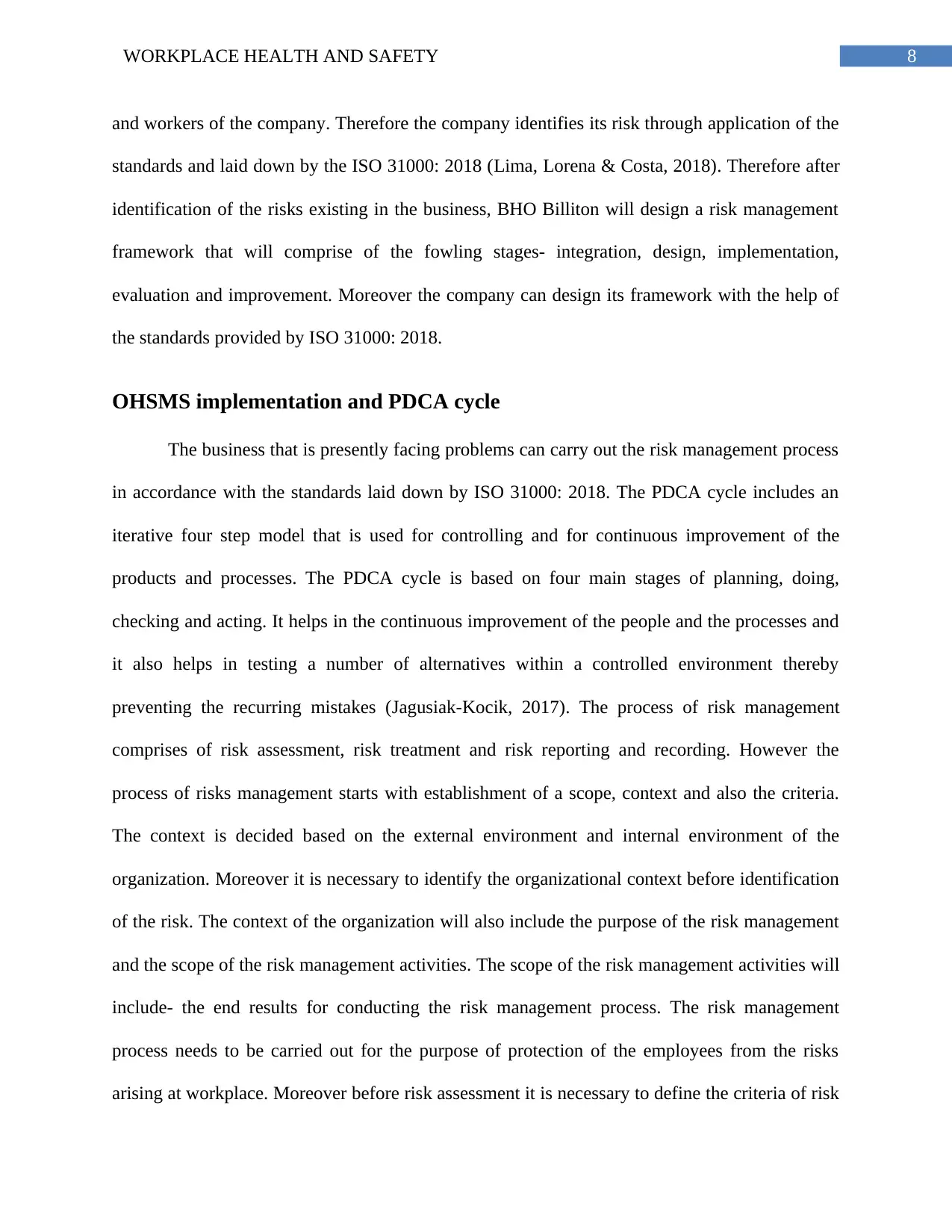
8WORKPLACE HEALTH AND SAFETY
and workers of the company. Therefore the company identifies its risk through application of the
standards and laid down by the ISO 31000: 2018 (Lima, Lorena & Costa, 2018). Therefore after
identification of the risks existing in the business, BHO Billiton will design a risk management
framework that will comprise of the fowling stages- integration, design, implementation,
evaluation and improvement. Moreover the company can design its framework with the help of
the standards provided by ISO 31000: 2018.
OHSMS implementation and PDCA cycle
The business that is presently facing problems can carry out the risk management process
in accordance with the standards laid down by ISO 31000: 2018. The PDCA cycle includes an
iterative four step model that is used for controlling and for continuous improvement of the
products and processes. The PDCA cycle is based on four main stages of planning, doing,
checking and acting. It helps in the continuous improvement of the people and the processes and
it also helps in testing a number of alternatives within a controlled environment thereby
preventing the recurring mistakes (Jagusiak-Kocik, 2017). The process of risk management
comprises of risk assessment, risk treatment and risk reporting and recording. However the
process of risks management starts with establishment of a scope, context and also the criteria.
The context is decided based on the external environment and internal environment of the
organization. Moreover it is necessary to identify the organizational context before identification
of the risk. The context of the organization will also include the purpose of the risk management
and the scope of the risk management activities. The scope of the risk management activities will
include- the end results for conducting the risk management process. The risk management
process needs to be carried out for the purpose of protection of the employees from the risks
arising at workplace. Moreover before risk assessment it is necessary to define the criteria of risk
and workers of the company. Therefore the company identifies its risk through application of the
standards and laid down by the ISO 31000: 2018 (Lima, Lorena & Costa, 2018). Therefore after
identification of the risks existing in the business, BHO Billiton will design a risk management
framework that will comprise of the fowling stages- integration, design, implementation,
evaluation and improvement. Moreover the company can design its framework with the help of
the standards provided by ISO 31000: 2018.
OHSMS implementation and PDCA cycle
The business that is presently facing problems can carry out the risk management process
in accordance with the standards laid down by ISO 31000: 2018. The PDCA cycle includes an
iterative four step model that is used for controlling and for continuous improvement of the
products and processes. The PDCA cycle is based on four main stages of planning, doing,
checking and acting. It helps in the continuous improvement of the people and the processes and
it also helps in testing a number of alternatives within a controlled environment thereby
preventing the recurring mistakes (Jagusiak-Kocik, 2017). The process of risk management
comprises of risk assessment, risk treatment and risk reporting and recording. However the
process of risks management starts with establishment of a scope, context and also the criteria.
The context is decided based on the external environment and internal environment of the
organization. Moreover it is necessary to identify the organizational context before identification
of the risk. The context of the organization will also include the purpose of the risk management
and the scope of the risk management activities. The scope of the risk management activities will
include- the end results for conducting the risk management process. The risk management
process needs to be carried out for the purpose of protection of the employees from the risks
arising at workplace. Moreover before risk assessment it is necessary to define the criteria of risk
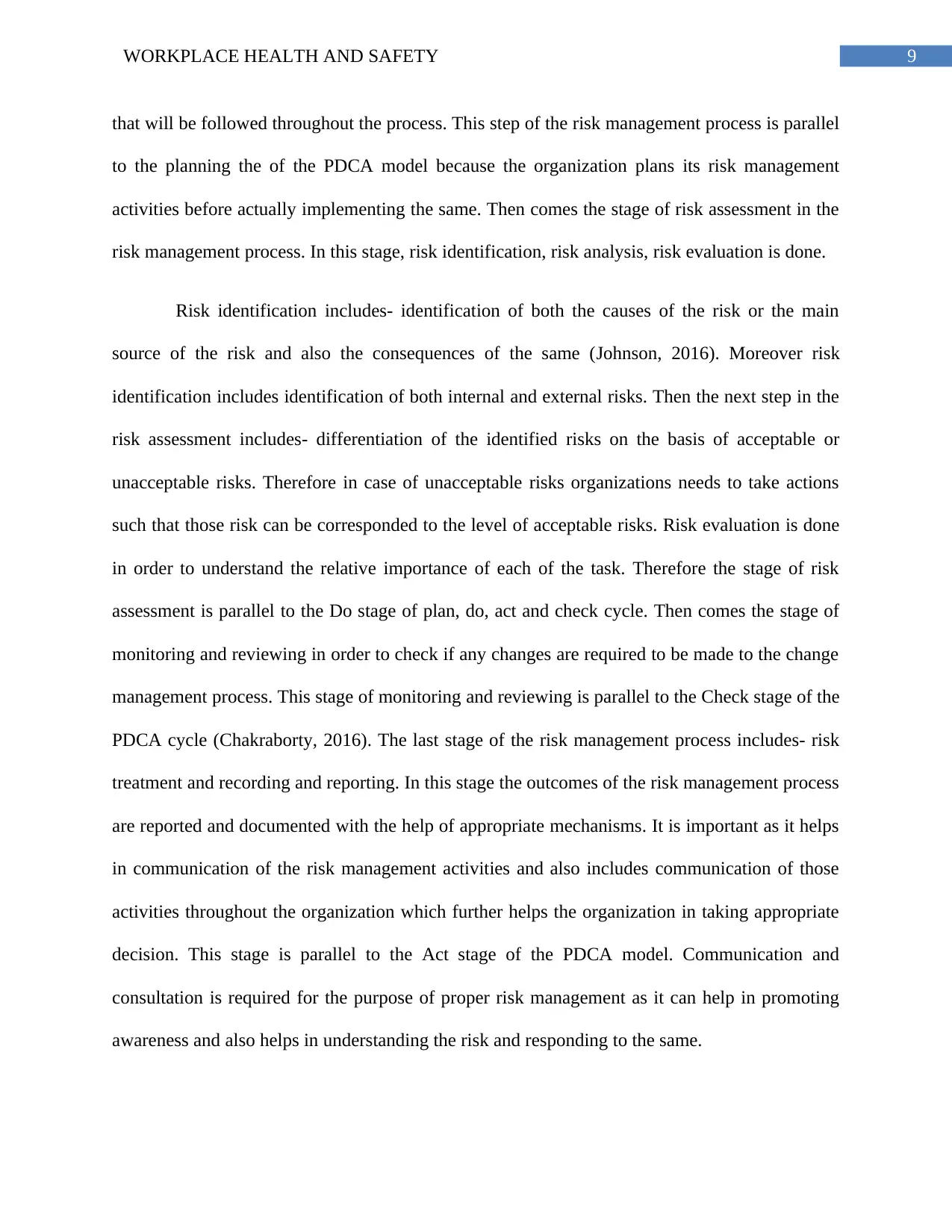
9WORKPLACE HEALTH AND SAFETY
that will be followed throughout the process. This step of the risk management process is parallel
to the planning the of the PDCA model because the organization plans its risk management
activities before actually implementing the same. Then comes the stage of risk assessment in the
risk management process. In this stage, risk identification, risk analysis, risk evaluation is done.
Risk identification includes- identification of both the causes of the risk or the main
source of the risk and also the consequences of the same (Johnson, 2016). Moreover risk
identification includes identification of both internal and external risks. Then the next step in the
risk assessment includes- differentiation of the identified risks on the basis of acceptable or
unacceptable risks. Therefore in case of unacceptable risks organizations needs to take actions
such that those risk can be corresponded to the level of acceptable risks. Risk evaluation is done
in order to understand the relative importance of each of the task. Therefore the stage of risk
assessment is parallel to the Do stage of plan, do, act and check cycle. Then comes the stage of
monitoring and reviewing in order to check if any changes are required to be made to the change
management process. This stage of monitoring and reviewing is parallel to the Check stage of the
PDCA cycle (Chakraborty, 2016). The last stage of the risk management process includes- risk
treatment and recording and reporting. In this stage the outcomes of the risk management process
are reported and documented with the help of appropriate mechanisms. It is important as it helps
in communication of the risk management activities and also includes communication of those
activities throughout the organization which further helps the organization in taking appropriate
decision. This stage is parallel to the Act stage of the PDCA model. Communication and
consultation is required for the purpose of proper risk management as it can help in promoting
awareness and also helps in understanding the risk and responding to the same.
that will be followed throughout the process. This step of the risk management process is parallel
to the planning the of the PDCA model because the organization plans its risk management
activities before actually implementing the same. Then comes the stage of risk assessment in the
risk management process. In this stage, risk identification, risk analysis, risk evaluation is done.
Risk identification includes- identification of both the causes of the risk or the main
source of the risk and also the consequences of the same (Johnson, 2016). Moreover risk
identification includes identification of both internal and external risks. Then the next step in the
risk assessment includes- differentiation of the identified risks on the basis of acceptable or
unacceptable risks. Therefore in case of unacceptable risks organizations needs to take actions
such that those risk can be corresponded to the level of acceptable risks. Risk evaluation is done
in order to understand the relative importance of each of the task. Therefore the stage of risk
assessment is parallel to the Do stage of plan, do, act and check cycle. Then comes the stage of
monitoring and reviewing in order to check if any changes are required to be made to the change
management process. This stage of monitoring and reviewing is parallel to the Check stage of the
PDCA cycle (Chakraborty, 2016). The last stage of the risk management process includes- risk
treatment and recording and reporting. In this stage the outcomes of the risk management process
are reported and documented with the help of appropriate mechanisms. It is important as it helps
in communication of the risk management activities and also includes communication of those
activities throughout the organization which further helps the organization in taking appropriate
decision. This stage is parallel to the Act stage of the PDCA model. Communication and
consultation is required for the purpose of proper risk management as it can help in promoting
awareness and also helps in understanding the risk and responding to the same.
Secure Best Marks with AI Grader
Need help grading? Try our AI Grader for instant feedback on your assignments.
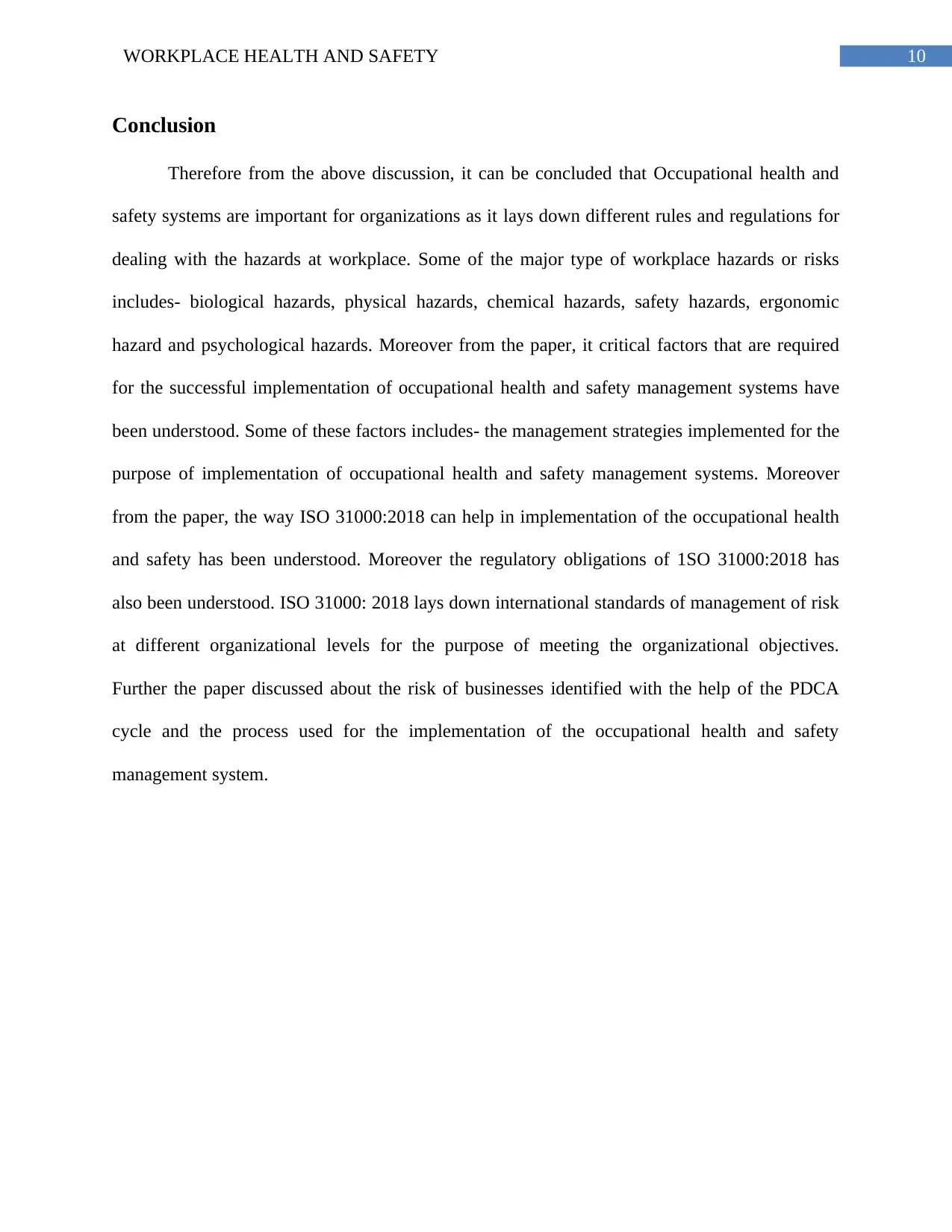
10WORKPLACE HEALTH AND SAFETY
Conclusion
Therefore from the above discussion, it can be concluded that Occupational health and
safety systems are important for organizations as it lays down different rules and regulations for
dealing with the hazards at workplace. Some of the major type of workplace hazards or risks
includes- biological hazards, physical hazards, chemical hazards, safety hazards, ergonomic
hazard and psychological hazards. Moreover from the paper, it critical factors that are required
for the successful implementation of occupational health and safety management systems have
been understood. Some of these factors includes- the management strategies implemented for the
purpose of implementation of occupational health and safety management systems. Moreover
from the paper, the way ISO 31000:2018 can help in implementation of the occupational health
and safety has been understood. Moreover the regulatory obligations of 1SO 31000:2018 has
also been understood. ISO 31000: 2018 lays down international standards of management of risk
at different organizational levels for the purpose of meeting the organizational objectives.
Further the paper discussed about the risk of businesses identified with the help of the PDCA
cycle and the process used for the implementation of the occupational health and safety
management system.
Conclusion
Therefore from the above discussion, it can be concluded that Occupational health and
safety systems are important for organizations as it lays down different rules and regulations for
dealing with the hazards at workplace. Some of the major type of workplace hazards or risks
includes- biological hazards, physical hazards, chemical hazards, safety hazards, ergonomic
hazard and psychological hazards. Moreover from the paper, it critical factors that are required
for the successful implementation of occupational health and safety management systems have
been understood. Some of these factors includes- the management strategies implemented for the
purpose of implementation of occupational health and safety management systems. Moreover
from the paper, the way ISO 31000:2018 can help in implementation of the occupational health
and safety has been understood. Moreover the regulatory obligations of 1SO 31000:2018 has
also been understood. ISO 31000: 2018 lays down international standards of management of risk
at different organizational levels for the purpose of meeting the organizational objectives.
Further the paper discussed about the risk of businesses identified with the help of the PDCA
cycle and the process used for the implementation of the occupational health and safety
management system.
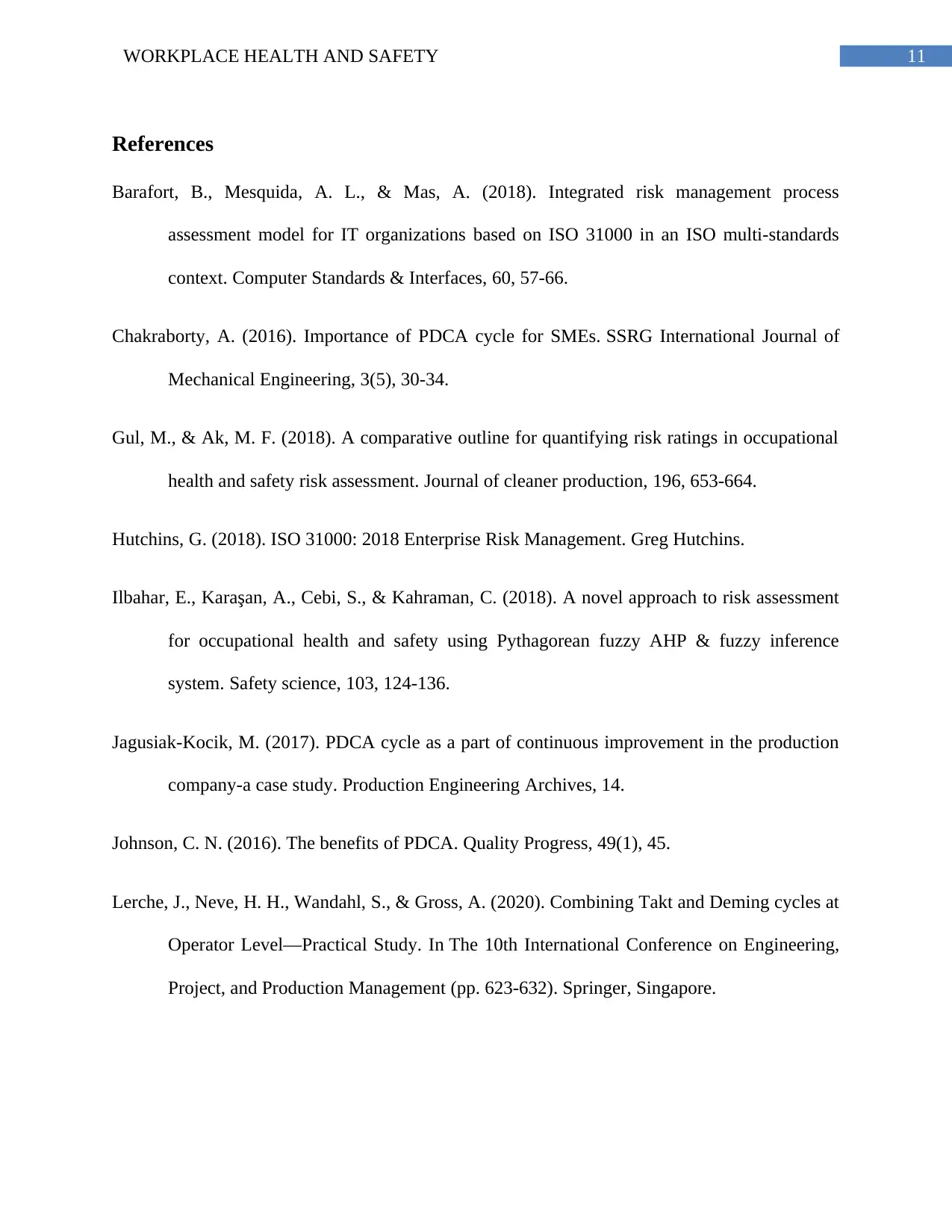
11WORKPLACE HEALTH AND SAFETY
References
Barafort, B., Mesquida, A. L., & Mas, A. (2018). Integrated risk management process
assessment model for IT organizations based on ISO 31000 in an ISO multi-standards
context. Computer Standards & Interfaces, 60, 57-66.
Chakraborty, A. (2016). Importance of PDCA cycle for SMEs. SSRG International Journal of
Mechanical Engineering, 3(5), 30-34.
Gul, M., & Ak, M. F. (2018). A comparative outline for quantifying risk ratings in occupational
health and safety risk assessment. Journal of cleaner production, 196, 653-664.
Hutchins, G. (2018). ISO 31000: 2018 Enterprise Risk Management. Greg Hutchins.
Ilbahar, E., Karaşan, A., Cebi, S., & Kahraman, C. (2018). A novel approach to risk assessment
for occupational health and safety using Pythagorean fuzzy AHP & fuzzy inference
system. Safety science, 103, 124-136.
Jagusiak-Kocik, M. (2017). PDCA cycle as a part of continuous improvement in the production
company-a case study. Production Engineering Archives, 14.
Johnson, C. N. (2016). The benefits of PDCA. Quality Progress, 49(1), 45.
Lerche, J., Neve, H. H., Wandahl, S., & Gross, A. (2020). Combining Takt and Deming cycles at
Operator Level—Practical Study. In The 10th International Conference on Engineering,
Project, and Production Management (pp. 623-632). Springer, Singapore.
References
Barafort, B., Mesquida, A. L., & Mas, A. (2018). Integrated risk management process
assessment model for IT organizations based on ISO 31000 in an ISO multi-standards
context. Computer Standards & Interfaces, 60, 57-66.
Chakraborty, A. (2016). Importance of PDCA cycle for SMEs. SSRG International Journal of
Mechanical Engineering, 3(5), 30-34.
Gul, M., & Ak, M. F. (2018). A comparative outline for quantifying risk ratings in occupational
health and safety risk assessment. Journal of cleaner production, 196, 653-664.
Hutchins, G. (2018). ISO 31000: 2018 Enterprise Risk Management. Greg Hutchins.
Ilbahar, E., Karaşan, A., Cebi, S., & Kahraman, C. (2018). A novel approach to risk assessment
for occupational health and safety using Pythagorean fuzzy AHP & fuzzy inference
system. Safety science, 103, 124-136.
Jagusiak-Kocik, M. (2017). PDCA cycle as a part of continuous improvement in the production
company-a case study. Production Engineering Archives, 14.
Johnson, C. N. (2016). The benefits of PDCA. Quality Progress, 49(1), 45.
Lerche, J., Neve, H. H., Wandahl, S., & Gross, A. (2020). Combining Takt and Deming cycles at
Operator Level—Practical Study. In The 10th International Conference on Engineering,
Project, and Production Management (pp. 623-632). Springer, Singapore.
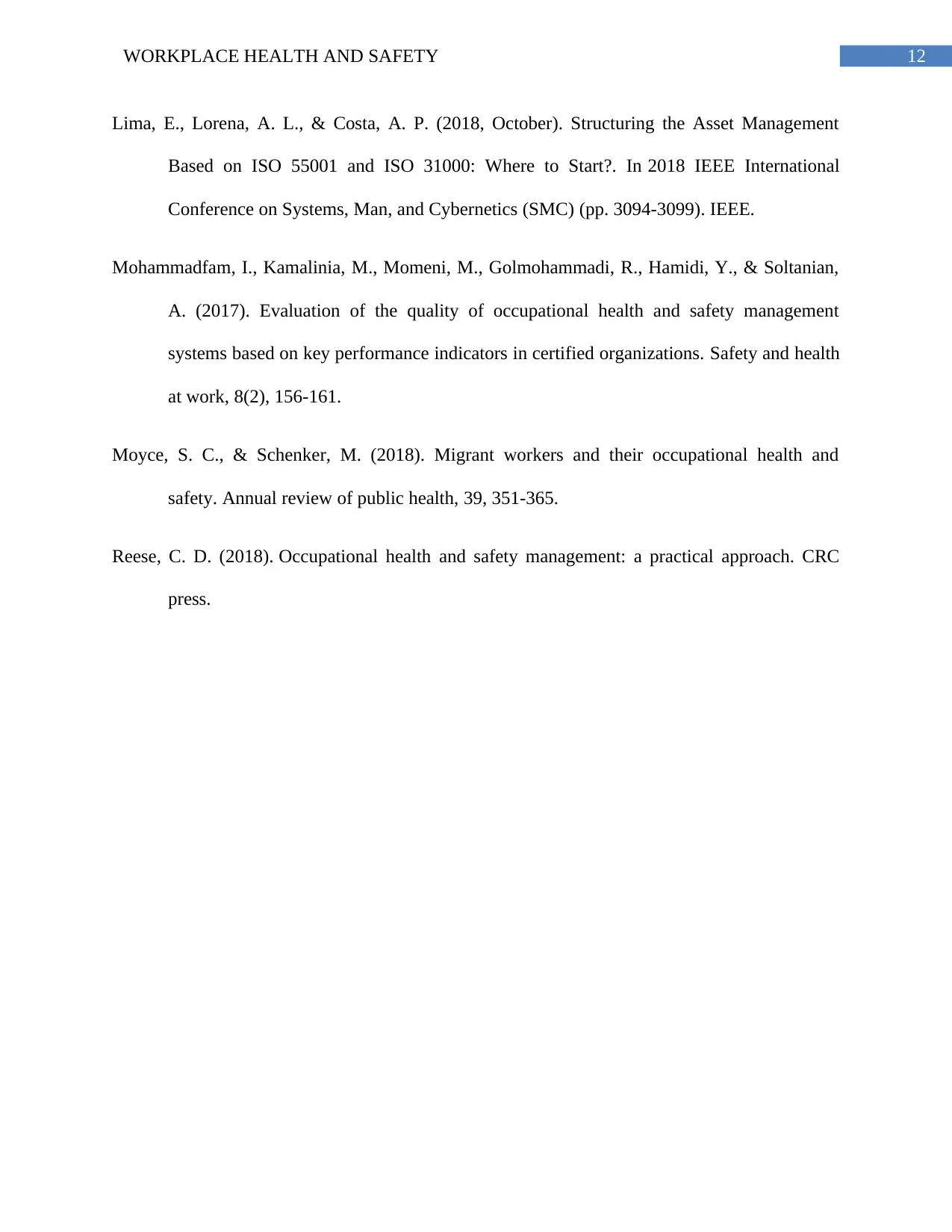
12WORKPLACE HEALTH AND SAFETY
Lima, E., Lorena, A. L., & Costa, A. P. (2018, October). Structuring the Asset Management
Based on ISO 55001 and ISO 31000: Where to Start?. In 2018 IEEE International
Conference on Systems, Man, and Cybernetics (SMC) (pp. 3094-3099). IEEE.
Mohammadfam, I., Kamalinia, M., Momeni, M., Golmohammadi, R., Hamidi, Y., & Soltanian,
A. (2017). Evaluation of the quality of occupational health and safety management
systems based on key performance indicators in certified organizations. Safety and health
at work, 8(2), 156-161.
Moyce, S. C., & Schenker, M. (2018). Migrant workers and their occupational health and
safety. Annual review of public health, 39, 351-365.
Reese, C. D. (2018). Occupational health and safety management: a practical approach. CRC
press.
Lima, E., Lorena, A. L., & Costa, A. P. (2018, October). Structuring the Asset Management
Based on ISO 55001 and ISO 31000: Where to Start?. In 2018 IEEE International
Conference on Systems, Man, and Cybernetics (SMC) (pp. 3094-3099). IEEE.
Mohammadfam, I., Kamalinia, M., Momeni, M., Golmohammadi, R., Hamidi, Y., & Soltanian,
A. (2017). Evaluation of the quality of occupational health and safety management
systems based on key performance indicators in certified organizations. Safety and health
at work, 8(2), 156-161.
Moyce, S. C., & Schenker, M. (2018). Migrant workers and their occupational health and
safety. Annual review of public health, 39, 351-365.
Reese, C. D. (2018). Occupational health and safety management: a practical approach. CRC
press.
1 out of 13
Related Documents
Your All-in-One AI-Powered Toolkit for Academic Success.
+13062052269
info@desklib.com
Available 24*7 on WhatsApp / Email
![[object Object]](/_next/static/media/star-bottom.7253800d.svg)
Unlock your academic potential
© 2024 | Zucol Services PVT LTD | All rights reserved.





